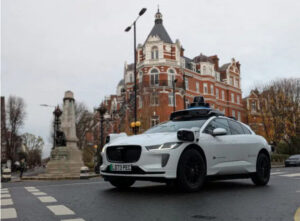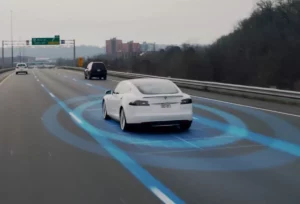The Connected Places Catapult (CPC) has celebrated its success in supporting the UK’s driverless vehicle industry become a world leader and shared many thought-provoking ideas and challenges at its virtual conference titled “What next for autonomous technology – opportunities for the UK”, that took place on 2 December.
The Catapult’s focus is to help innovative UK businesses grow to deliver new levels of physical, digital and social connectedness. Its Chief Delivery Officer Neil Fulton told more than 300 virtual delegates that two of the companies it’s supported, Aurrigo and Oxbotica, have become internationally influential since they were founded in the mid-2010s, and that the UK is in “pole position” in the global race to market for Connected and Automated Vehicles, which could bring a £62 billion pound boost to the economy by 2030.
The event focussed on four main areas around Autonomous technology: Decarbonisation, the here-and-now, the connected infrastructure and trust & acceptability.
The virtual sessions kicked off with CPC launching its latest report, titled ‘The CAV Decarbonisation Paradox’, which explores how CAV technology has the potential to make significant contributions to the decarbonisation of transport. However, there is a risk of negative environmental consequences if deployment and policy interventions are not carefully considered. Click here to read the report.
Solutions delivering a difference to communities now were discussed, including the Starship delivery robots in Milton Keynes. More than a hundred are currently in use, taking groceries to people in an average of just 43 minutes from when their orders were placed. This new level of convenience, explained its VP of Marketing Henry Harris-Burland, is changing consumer habits among the 50,000-home catchment in Milton Keynes and is now expanding to reach another 5,000 households in Northampton, with a national roll-out being planned.
Making sure that people are at the centre of all developments was central to another presentation, from Ed Houghton of DG Cities on Project Endeavour. He explained the research being undertaken to explore the use of autonomous vehicles in urban settings and how to create a really clear framework of safety, and then test user perceptions and experiences. The project builds on previous deployments of CAV technology, and incorporates what has been learned in order to deliver a “people centred” approach, with safety and trust at its heart. “We do this in a way to try and maximise the impact of this technology in a way that can accelerate and support the growth of autonomous vehicle technology,” he said, “and look closely at user engagement and user experience.”
Trust and trustworthiness, and the legal aspects around CAVs, was also discussed in detail, centring around the interaction between humans and machines. Professor Sarvapali Ramchurn, a Director at the Centre for Machine Intelligence at Southampton University, explained how there is no one-size-fits-all solution when it comes to designing how people use a vehicle, and that different contexts and uses need different interfaces, what he called “flexible autonomy”.
He also cautioned about the terminology used, and over-promising solutions to the public that could confuse the would-be users about what the vehicles do and how they do it. Particularly he called on the industry to not swap around the use of “autonomous”, “automated”, “self-driving” and “driverless” without defining whether they mean the same thing, or different things.
“There’s not much research going on it right now in terms of explaining concepts to a general audience and in helping industry market those products in the right way,” he said. “The audience is in need of short 140-character type messages that they can grasp very quickly. It’s becoming increasingly difficult to shape public perception of these autonomous vehicles, and we need to work hard on setting the guidelines and how we promote these justifications to use autonomous vehicles, and all sorts of autonomous technologies.”
The conference also discussed legal aspects, and how the Highway Code will need to adapt to more automation. Barrister Alex Glassbrook commented how drivers are expected to be in control and that the driver must read and understand the manual, but that certain areas of driver assistance aids in the vehicle are far from intuitive. However, he did praise the UK, pointing out that the Centre for Connected and Autonomous Vehicles (CCAV) was founded in 2015, that the Law Commission has been involved since very shortly after that, and that “We have a statute on the statute book – that’s more than the United States has. We’re in a good strong position.”
“A potentially key area is to encourage the use of shared vehicles,” suggested Dr Zeyn Saigol, Principal Technologist in New Mobility at the CPC. “In these COVID times, you might want to focus developers on creating isolated compartments to make users much more comfortable to use a shared vehicle. You might want to subsidise HARPS, which are highly automated road passenger services or “Robo-taxis”, in rural areas, and perhaps, similar to the way that shipping container sizes have been standardised and really helped that industry, you could standardise cargo bays for automated goods vehicles.”
It was generally agreed among the speakers that, given COVID had affected the desirability for shared mobility at least in the short term, freight was a great opportunity for CAVs. Paul Clarke, formerly of Ocado, explained how this year has seen a shift from passengers to deliveries. That is partly because of trying to implement a low touch economy, but also because the safety case around autonomous delivery is a more attractive one. He explained, “Obviously you still have to avoid hitting and injuring people, but at least in terms of what you’re carrying, your cargo is arguably slightly less of a safety critical nature.”
There was some disagreement between panellists about safety, with Paul Clarke saying we should not get “hysterical” about it because, compared to human drivers, autonomous vehicles will be much safer, although accidents will still happen. However, Mike Potts, co-founder of Streetdrone, cautioned that “society is unforgiving of machines that kill people” and suggested that full automation should only happen at slower speeds.
Panellists said that there was a need to remember the business case at all times during development and that engineers should not “create a technology waiting for a business model to happen.” They agreed autonomy is not a product, it is a service, and that the industry should not expect the built environment to change dramatically to accommodate CAVs, because it is unrealistic to expect the world to change its entire infrastructure for autonomy – we need to make this viable in the environment that exists already. The advice of the day for the industry? Have a clear vision of where we want to be in the decades to come and implement it incrementally.
The conference demonstrates that Autonomous technology has the potential to improve the movement of people and goods and that the UK, with continued focus and collaboration, can be a global leader in this sector. The Connected Places Catapult team look forward to continuing to work with Government, Industry and academia to help realise this opportunity.
To watch the conference presentations click here
(Graphic – Connected Places Catapult)






















